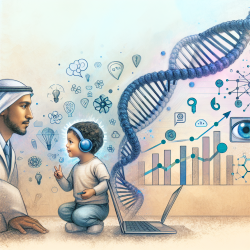Introduction
The advent of genetic research has opened new avenues in understanding human traits and their variations. A recent study titled "Meta-analysis of genome-wide association studies identifies 8 novel loci involved in shape variation of human head hair" has provided valuable insights into the genetic determinants of hair shape. While this might seem unrelated to speech-language pathology at first glance, there are significant implications for practitioners in this field, especially those focused on creating data-driven, individualized therapy plans for children.
Understanding Genetic Influence on Development
As speech-language pathologists, understanding the genetic basis of certain traits can enhance our ability to tailor interventions. The study identified eight novel loci that contribute to hair shape variation, demonstrating the power of genome-wide association studies (GWAS) in uncovering genetic influences. This methodology can be applied to speech and language development, where genetic predispositions may affect outcomes.
Implications for Speech Therapy
Incorporating genetic insights into speech therapy can lead to more personalized and effective interventions. Here’s how practitioners can leverage these findings:
- Data-Driven Assessment: Utilize genetic information to assess predispositions that might influence speech and language development. Understanding a child's genetic makeup can provide clues about potential challenges and strengths.
- Tailored Interventions: Develop interventions that consider genetic predispositions. For instance, if a child has a genetic marker associated with a particular speech or language difficulty, interventions can be customized to address these specific challenges.
- Collaborative Research: Engage in collaborative research to explore the genetic basis of speech and language disorders. This can lead to the identification of new loci associated with these conditions, similar to the hair shape study.
Encouraging Further Research
The study highlights the importance of continued research in genetics and its application to various fields, including speech-language pathology. Practitioners are encouraged to stay informed about genetic research developments and consider how these insights can be integrated into practice.
Conclusion
While the study on hair shape genetics might seem distant from speech therapy, it underscores the potential of genetic research in enhancing our understanding of human development. By embracing data-driven approaches and integrating genetic insights, speech-language pathologists can improve therapy outcomes for children.
To read the original research paper, please follow this link: Meta-analysis of genome-wide association studies identifies 8 novel loci involved in shape variation of human head hair.










